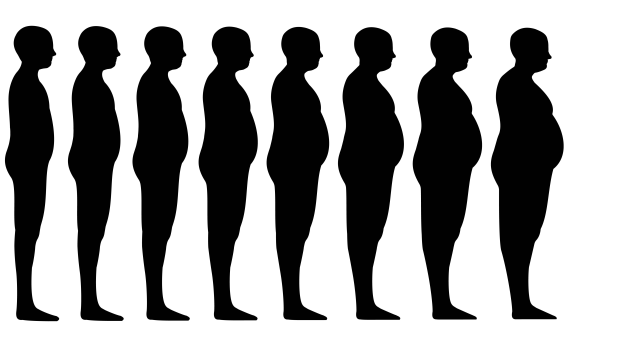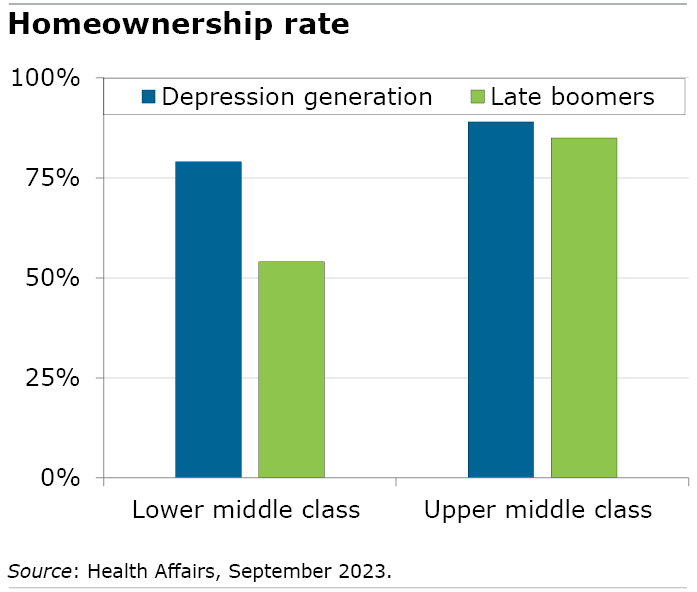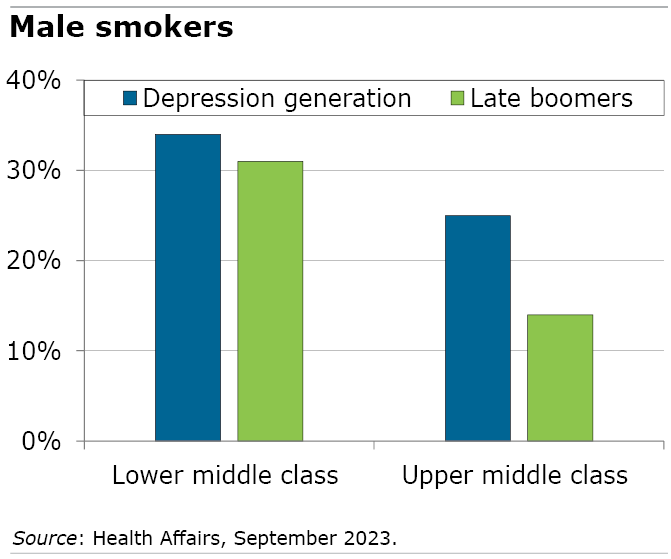
The fortunes of Individuals whose wealth is within the prime 10 % have soared, leaving the remainder of the nation trailing of their wake. However let’s focus as an alternative on the unsettling traits which have developed inside the center class.
Each the well being and funds of older staff have deteriorated within the backside half of “the forgotten center” over the previous 20 years, in keeping with researchers on the College of Southern California and Columbia College.
Take one necessary indication of this. Residence fairness is often an older employee’s largest single asset. However homeownership has fallen sharply within the backside half of what the researchers outline because the 60 % of older Individuals within the center class.
The homeownership fee within the decrease center class was 79 % within the era born late within the Melancholy however slid to 54 % for the final of the boomers born within the early 1960s. Distinction them to the higher center class: 85 % of the late boomers personal a home.

That is simply one of many disparities between the highest and backside halves of the center class that “widened considerably between 1994 and 2018,” the researchers stated.
They repeated their technique of utilizing easy statistics for varied measures of bodily and socioeconomic well being to trace modifications over time for individuals who had been between ages 53 and 58 in 5 completely different years: 1994 (the Melancholy era), 2000, 2006, 2012, and 2018 (the late boomers).
To match the cohorts, the researchers ranked and sorted people in every cohort into socioeconomic subgroups based mostly on a mixture of their annual earnings and estimates of the present worth of their wealth, annualized. The decrease center class is the 15th to 44th percentiles by way of their monetary sources. The 15th percentile is the federal poverty stage, so the lower-middle class on this examine additionally contains very low-paid staff. The higher center class is the 45th to 75th percentiles.
The financial hole has widened in varied methods because the decrease center class has fallen additional behind. Each their earnings and the share who had been employed have stagnated over the many years. The share with employer medical insurance plunged from 76 % of the Melancholy era in 1996 to 46 % of the late boomers in 2018, although many might have ended up on government-subsidized healthcare.

In distinction, employment within the higher center class rose barely, and the earnings of the late boomers on this group are 30 % larger than the Melancholy era’s earnings. Their employer medical insurance fee has been each larger and steady over that point.
To be clear, the well being of all 53- to 58-year-olds has deteriorated, a troubling pattern that has been confirmed by earlier analysis. For instance, the variety of power situations reported by each the upper- and lower-middle courses have elevated, this new examine discovered.
However the decrease center class has fared worse. One in 5 members within the Melancholy era stated they had been in poor or truthful well being in 1994. By 2018, that had jumped to just about one in three late boomers. Within the higher center class, the share in poor or truthful well being has stayed at about 10 % of ladies and has risen to 17 % of males – nonetheless effectively under the speed for males within the decrease center class.
Smoking, an easy indication of well being, has fallen fairly a bit over the many years within the higher center class. The smoking fee hasn’t modified a lot within the decrease center class. The speed was 25 % for ladies and 31 % for males in 2018.

Weight problems is one well being statistic that runs counter to the pattern. Regardless of the higher center class being more healthy in most methods, the weight problems charges in each the higher and decrease center class have risen sharply.
However the principle conclusion of the researchers is that the deprived folks within the backside half of the forgotten center are “being left behind in comparison with these with larger financial standing, whose anticipated well being and financial sources have grown considerably.”
Squared Away author Kim Blanton invitations you to observe us on Twitter @SquaredAwayBC. To remain present on our weblog, please be a part of our free electronic mail record. You’ll obtain only one electronic mail every week – with hyperlinks to the 2 new posts for that week – whenever you enroll right here. This weblog is supported by the Middle for Retirement Analysis at Boston School.




